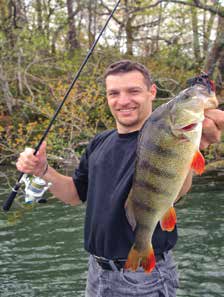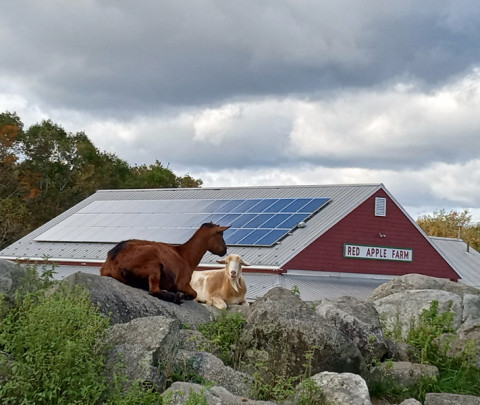Fish Tales
- Visit North Central
Here’s a Line on Some Local Hot Spots
From sunlit quiet-water pools to shady cold-water rapids, the rivers of North Central Massachusetts offer a wealth of options for fishermen.
The region’s abundant protected land ensures high-quality water, habitat for a variety of cold and warm-water species, and a wealth of places to explore. And here’s a boost: Many waterways are stocked with trout during the spring and early autumn (see sidebar).
Rollin’ on the River
The Nashua River watershed offers many prime destinations, including numerous cold-water streams with abundant native brook trout. The main stem of the Nashua River, which flows north out of Wachusett Reservoir to the Merrimack River in southern New Hampshire, is known for its clean water, thanks to its extensive forest buffer. One of the largest protected corridors encompasses the Bolton Flats Wildlife Management Area and Oxbow National Wildlife Refuge in Bolton and Harvard. Here there are opportunities for largemouth bass, yellow perch, brown bullhead, sunfish, and other species. At the Oxbow Refuge, fishing is allowed in the Nashua River, but not in other wetlands. A canoe launch is located near the main entrance off Still River Road.
Further upstream, another popular destination is Pepperell Pond, formed by a dam on the river in Pepperell center. It’s an excellent spot for large and small-mouth bass, and the site of many local fishing tournaments. A cartop boat launch is located on Canal Street near the junction with Main Street.
Another productive area in Pepperell is the Nissitissit River, an 11-mile long tributary of the Nashua River. Thanks to conservation efforts, about half of its shoreline is protected. The Nissitissit is home to the state’s first catch and release fly fishing area, which extends for nearly two miles from the Prescott Street bridge to the New Hampshire state line. The river is stocked in spring and fall with brown, brook, and rainbow trout. One of the best access areas is the Nissitissit River Wildlife Management Area on Brookline Road just south of the New Hampshire state line. Nearby Gulf Brook and Heald Pond offer additional opportunities.
 The Squannacook River, another major tributary of the Nashua River, offers many diverse locations along its 16-mile course in Townsend, Groton, and Shirley, including slow and fast-water sections, and deep pools favored by large brown trout. Nearly 20 percent of its watershed is protected, offering anglers plenty of public land to explore. Access areas include Townsend State Forest near the headwaters in West Townsend, and Squannacook River Wildlife Management Area, which protects nearly 1000 acres along both banks of the river.
The Squannacook River, another major tributary of the Nashua River, offers many diverse locations along its 16-mile course in Townsend, Groton, and Shirley, including slow and fast-water sections, and deep pools favored by large brown trout. Nearly 20 percent of its watershed is protected, offering anglers plenty of public land to explore. Access areas include Townsend State Forest near the headwaters in West Townsend, and Squannacook River Wildlife Management Area, which protects nearly 1000 acres along both banks of the river.
Salmon, Anyone?
In Princeton and Sterling, the 10-mile long Stillwater River serves as a source of the Wachusett Reservoir and the south branch of the Nashua River. One of the river’s unique features is its population of reproducing landlocked Atlantic salmon. In autumn, usually when the water flow increases, salmon from the Wachusett Reservoir enter the river to mate and lay eggs in nests in the riverbed. Landlocked freshwater salmon, which generally average between 2 and 4 pounds in Massachusetts, are much smaller than sea-run salmon, which grow as large as 20 pounds.
The Whitman River and Phillips Brook, which flow from the lakes of Ashburnham through Westminster and Fitchburg, are stocked annually with trout. Both waterways merge in Fitchburg to form the North Nashua River.
Open quiet-water meadows and backwaters, hemlock-shaded rapids, and pools are among the many features of the Ware River and its tributaries. The best fishing in the spring is in the upper portion of the watershed, which is part of a large area of protected land in Hubbardston and Barre that includes the Ware River Reservation and Barre Falls Dam. The river is stocked with trout, and other frequently-caught species include bass, yellow perch, and pickerel.
In addition to its value as Quabbin Reservoir’s largest source water, the East Branch of the Swift River is another waterway with diverse habitats. The upper portion of the river is slow with boggy wetlands, while the segment from Popple Camp in Phillipston to the river’s confluence with Quabbin Reservoir at Pottapaug Pond in Petersham includes rocky, cold-water segments interspersed with several ponds, including Connors Pond on Route 122. Author William Foye’s Trout Waters (Haley’s Publishing, 1992) is an excellent source of information on fishing and the natural history of the Swift River Valley.
The Millers River, the largest tributary of the Connecticut River in central Massachusetts, has long been known as a prime fishing destination. Popular destinations in the upper watershed include the Otter River, Lake Dennison, Birch Hill Dam, Priest Brook, and Lawrence Brook. Downstream is a catch and release area that extends from the South Royalston railroad bridge to the Starrett Tool Company dam in Athol.
The following waters are stocked with trout each spring. Want to know more?
Check out the Massachusetts Department of Fisheries and Wildlife website (mass.gov/eea).
— John Burk








